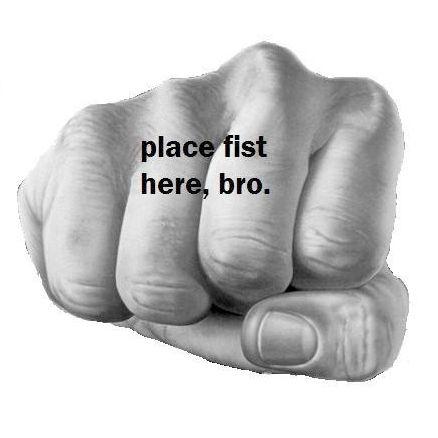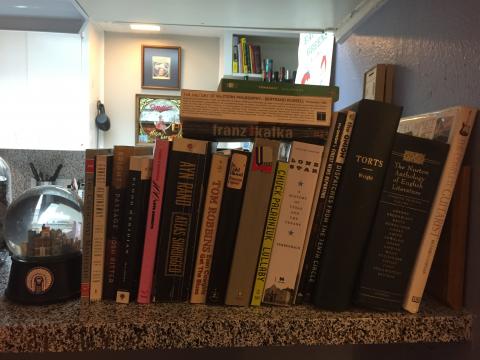And Now, A Reading from The Book of Bro

Image Source: http://knowyourmeme.com/memes/bro
Brainstorming with my fellow viz. writers on matters related to book covers and the rhetoric thereof, I mentioned my interest in the Chick Lit phenomenon. After politely listening to the sound of a dead horse being dug up from its grave and beat relentlessly, there was a collective eye roll and sigh. For more reasons than I have time to list at the moment, I realized very quickly that the nonplussed reception was more than justified. We kept bouncing around ideas, and touched upon the question of whether there was a male equivalent of Chick Lit. Or, to use the term that our editor Rhiannon invented, is there such a thing as “Bro Books?”
It was an awesome idea, and what follows is my attempt to run with it.
So, let's talk Bro Books.
Before we can define what, exactly, constitutes a “bro book,” we need to define what, exactly, constitutes a “bro.” Derived from the word “brother,” people have been employing the term “bro” as far back as the 1600s; it was in the early 1900s that the term gained specificity and began being used to address someone (generally male) whom one was close with and fond of. http://knowyourmeme.com/memes/bro. More recently, however, the referent of the term “bro” has increased in specificity, losing some of its positive connotations. So we need to parse this out a bit more if we want to arrive at a solid working definition.
But where to begin?
“Bro-ness” is one of those you-know-it-when-you-see-it kind of things. In his excellent posting on the blog “codeswitch,” entitled “Jeah! We Mapped Out The 4 Basic Aspects Of Being A 'Bro,”’ author Gene Demby provides a great example of bros via gif:
"Y’all know who we mean. These cats right here:”

Image Source: http://img.gawkerassets.com/img/185wsu7f62b33gif/k-bigpic.gif
But Demby’s “Y’all know who we mean” is about as productive as the “you know it when you see it” that I spit out above as far as articulating a definition of a bro is concerned. Thankfully, Demby digs deeper for us, using a Venn Diagram to illustrate his definition of the quintessential bro as being equal parts (1) Jockish, (2) Stoner-ish, (3) Preppy, and (4) (my favorite) “Dude-ly.” http://www.npr.org/blogs/codeswitch. Demby also provides some examples of bro behavior to fill out the picture, such as fist-bumping, posting pics with other bros doing “bro-ass things,” and “juggl[ing] a sporting life and [a] salubrious appetite for alcohol.” (Id.)
While this is all helpful, I feel as though Dembly misses the two most critical criteria of being a bro. For one thing, he doesn’t seem to account for the most “bro-ass” activity of them all: seeking out members of the opposite sex for romantic dalliances (read: bar hopping in search of drunken casual sex). He seems to forget that, even among bros that are “super tight,” there’s no bromance strong enough to completely supersede a bro’s fundamental desire to hit the bars and “chase some tail.” Put simply, while it is irrefutablely true that bros like watching a football game together, there’s a reason that they’re frequently doing so at Hooter’s that deserves consideration.
I would also humbly suggest that Demby also gives short shrift to what I see as the second definitive characteristic of bro-ness. Specifically, a bro is always conscious of whether they’re “looking the part,” regardless of whether they acknowledge that “the part” is that of a bro (I would describe this to my undergraduates as the bro’s ethos). The aim is to present one’s self as the guy who’s “cool” enough to afford his $65 pair of J. Crew cargo shorts, but “chill” enough not to notice that they don’t match the throwback Chicago Cubs jersey that he’s rocking on top. (After all, what could possibly be more un-bro than worrying about stuff like whether your hat looks cooler forwards or backwards or slightly askew when there’s a cooler full of brew-dogs that need a poundin’! Am I right, Bro?! Fist-bumps!!)
We can further refine out definition by looking at what a bro is not. As I am defining a bro for present purposes, age is of little relevance. While the definition we’ve been refining has probably painted a picture of a young individual, you can be a bro at any age whatsoever. Replace the J. Crew cargos and Cubs jersey mentioned above with Dockers and a Ralph Lauren polo shirt, and you’ve got the same bro, except with several more decades of bro-ing it out under his belt. It would appear Demby agrees with me on the (in)significance of age in defining “bro,” given that age is not at all invoked in his comprehensive “4 Pillars” theory and accompanying diagram (see above). Demby and I also seem to agree that the propriety of using race as a defining characteristic of a bro is troubled, at best. Demby set out to determine whether the term “bro” had a racial component to it, his research did not show that any such component existed, at least not one that’s consistently agreed upon. (Id.)
Now that we have put together a working definition of “bro,” can we finally define the term “bro books?”
Well, kinda.
Remaining consistent with the mode of analysis we’ve been employing thusfar, let’s illuminate via illustration what we mean when we talk about “bro books.” Below is the quintessence of a bro book collection.

Image Source: The Private Collection of viz.'s Resident Dude
Because the totality of a collection of bro books is as important as the presence of any particular book, it is important to look at the collection as a whole. For the bro, the physicality of his books (individually and collectively) is the first and foremost consideration. Just as was the case with bro clothing, bro books need to look as though they were simply “thrown together” by the bro in question. A neatly organized shelf of books would be anything but “chill.” Further, having many books of the same genre, author, historical period, etc. might appear as though there’s a particular topic that a bro cares deeply about, which is not at all in keeping with the bro’s MO. So, each book is carefully chosen in and of itself and in its relation to the collection as a whole. Almost invariably, the “audiences” the bro has in mind are (1) fellow bros who have come over for a bro-ass activity, or (2) a woman the bro would like to impress. Let's look at a sample from the above collection of bro books:
1. Anything by Chuck Palahniuk. Preferably “Fight Club,” but any of his others will do. This one’s aimed at the audience of fellow bros more than the female object of his desire.
2. Anything by Hemingway. Preferably more than one title.
3. “The Complete Guitarist.” It says that you have other interests and skills, and playing the most bro-ass instrument of them all is one of those pastimes.
4. A law textbook. In this case, “Torts,” by Richard Wright. An impressive looking law-related book is an absolute must for any collection deserving of the name “bro books.” I mean, just look at it! Heavy. Dense. The no-nonsense cover is supposed to be taken as representative of the nature of its contents, as well as the contents of the bro's character.
5. “100 Love Sonnets,” by Pablo Neruda. He may seem like just another beer-chugging jock, but he appreciates perusing poetry as much as he does “whaling on his pecs at the gym.” This suggests that that the lucky lady surveying this collection might even have some poetry read to her! (Fingers crossed!)
6. Collections of articles from “The Onion.” Guaranteed to get serious bro-grabs (excessively masculine versions of hugs).
Obviously, there’s much more that could be said about this bro book collection, but you get the idea.
In the end, then, the answer to this posting's original question would be in the affirmative, but in very different ways than are generally considered when seeking to identify categories of readers and/or reading. There are most certainly individual books as well as personal collections of books that could properly be called “bro books.” However, since one of their unifying characteristics is the attempt to have no unifying characteristics, it is hard to define bro books as a genre, per se. It would appear as though a book’s physical appearance, along with the cultural cache of title or author are the aspects of what gives a book its bro-ness. In creating and/or identifying a bro book collection, the actual words on any of the pages between those covers is an ancillary concern at best.
All of this should be taken with a grain of salt, of course. I am by no means the bro-thority on the nuances of bro-dome.



Add new comment